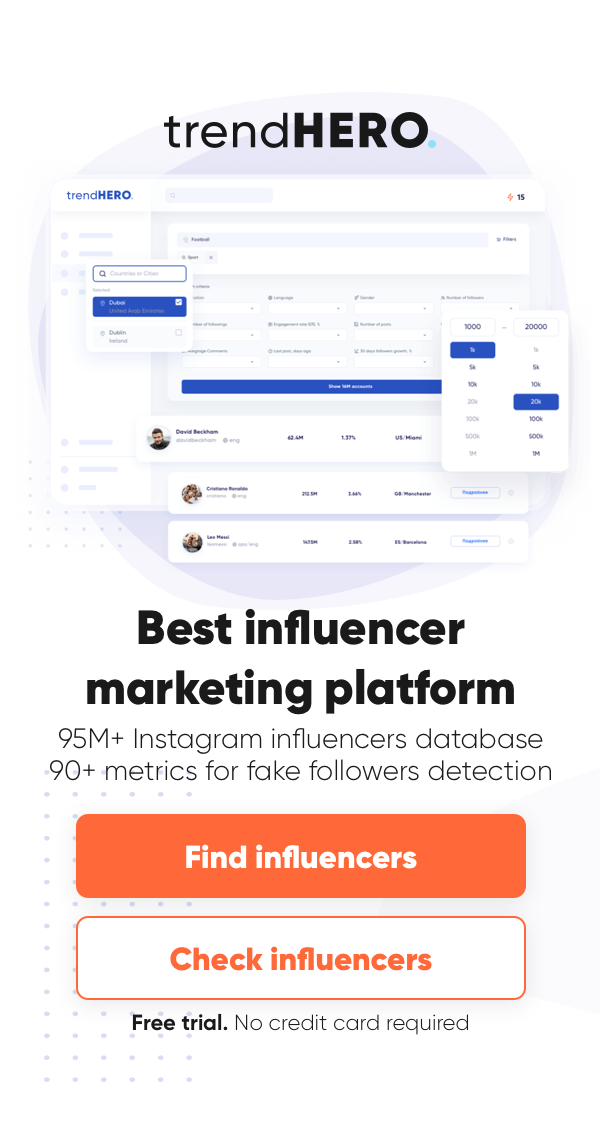- Home
- BLOG
- Instagram Marketing
- 8 Social Media Metrics That Matter to Your Business
So you have a beautifully designed social media account, you post regularly, and you run official ads. But how do you know you’re doing it right? The answer is simple: by tracking social media metrics.
Assessing these metrics helps you understand who your audience is, what your subscribers like, and which actions generate more sales.
We’ve put together these 8 metrics to help you understand if your promotion methods are effective.
8 most important social media marketing metrics to track
1. Engagement rate
Engagement rate (ER) is one of the main metrics to track on a social media account nowadays. For the most part, this metric affects the ranking of posts and stories that will be shown to users. You should constantly try to increase this metric so that your account appears in your subscribers’ feed more often.
You can calculate engagement on a per publication basis or you can calculate the total engagement for the account over a certain period of time.
The engagement per publication allows you to understand which posts get the best response from your subscribers and which ones you’d better exclude from your content strategy. The total account engagement rate helps assess the overall profile status and understand how well the chosen promotion strategy is working.
The ER is easy to calculate: (comments + likes + followers )/ subscribers * 100%. You can do it manually or simply use analytics services like trendHERO: they’ll do it for you.
The good ER is 5-10% and upwards.

Or you could use our free online Engagement Rate Calculator.
2. Subscribe vs unsubscribe rate
The ratio between subscriptions and unsubscriptions is also an important metric to keep an eye on at all times. If your profile’s unsubscriptions dynamic outweighs subscription, you risk getting a shadowban on Instagram and ceasing to show up in your subscribers’ feeds. The consequences of such a disproportionate subscription to unsubscription ratio on other platforms aren’t less daunting. That said, the growth in subscriptions shouldn’t be too steep to avoid making algorithms suspicious.

3. Percentage of inauthentic subscribers
Inauthentic subscribers include all kinds of bots, mass followers, and empty accounts. The more such subscribers on your account, the less activity and engagement on your profile.

4. Reach
Reach is the number of people who viewed your post. Monitor this metric to estimate the number of users who see your publications in their feed. If this value is low, you need to take action: arrange activities, run giveaways, launch promotions. Never underestimate this metric: what is the point in your many thousands of subscribers who do not even see your posts?
You can get a quick look at your Reach in Instagram Insights.
5. Conversion rate
Conversion is any desired action committed by users. If you have a website, the desired action is clicking on a link, if there’s email/phone information in your profile it can be clicking on those forms.
The main thing is to set your desired goals correctly, track this metric, and optimize it.
It’s easy to calculate: a number of conversions/number of views * 100%.
If your desired goal is to attract traffic to your website, you can track this metric in Google Analytics.
6. Mentions
One of the most important goals on any social media, especially on Instagram, is to increase your visibility. Therefore, you should always be interested in getting your profile mentioned in other accounts as often as possible. This increases brand awareness and organic subscriber growth.
Try to motivate users to create user-generated content, get influencers to promote you or shout you out. In other words, try as much as possible to promote positive mentions of your profile.
To evaluate the efforts you have made, just keep track of how many people mentioned you in a certain period, compare with the previous one and draw conclusions.
7. Audience demographics
Take as much time as possible to learn about your audience. This helps you shape and adjust effective account promotion. You can create more engaging content by knowing who your subscribers are. This will also help you reply to a message on Instagram more effectively and in an engaging way.
The main things to analyze are gender, age, location, days, and time when your audience is most active. Keep track of all this and adjust your content and marketing strategies based on this information.
You can find the data in Instagram Insights or, if you prefer much more in-depth info, try trendHERO profile reports.
8. Audience quality
This isn’t so much a metric as a set of metrics in your account stats that you need to track to understand if you’re broadcasting your content to the right audience.
As was mentioned above, Instagram shows basic demographic information about your current audience. You must have at least 100 followers to see demographics. You can see data on your followers by gender, age, the top five cities and countries your followers live in. You can also find out their activity by day and hour.
But what if your audience doesn’t meet your expectations?
You may have the wrong people subscribed to you. The ones who are unlikely to become your customers or appreciative viewers. For example, your store is based in New York but the majority of your subscribers are from California. Or your desired audience is 35-50-year-old men and your subscribers are mostly young ladies.
There are several ways to do a clean-up and improve your audience:
- Manually. Check out your subscribers;’ profiles and remove/block unwanted ones.
- Using targeted ads. You won’t get rid of unwanted subscribers, but you can influence the ratio: just run ads that will be shown to the right audience.
- Advertise with influencers who can speak to your target audience. Choose content creators who might have your potential customers as subscribers. To make sure they do, check out their profile analytics.
How to measure social media effectiveness
So you know what the most important metrics are. What should you do now?
First of all, it’s worth remembering that when working with social media, success directly depends on your marketing goals. Setting clear objectives will determine which metrics will be important to measure effectiveness.
Social media are mostly used by companies in their long-term promotion strategies. This determines the basic nature of the metrics used in social media marketing. In order to draw a complete picture, they need to be tracked over time rather than taken as a bunch of statistics at one particular moment.
As the saying goes, the ends justify the means. The way a company approaches social media platforms and what route it chooses for its customers determines the choice of key metrics it prefers to use. In practice, this means that it’s important not to track all existing KPIs in a row, but only those that serve as an indicator that your business is getting closer to its goal.
So how can you measure your growth on social media?
The first way to do that is by using the built-in analytics many social media platforms have. A competent SMM specialist can always extract the necessary data from the statistics.
The second way is to use third-party analytics tools. These offer a much bigger picture: what users did when they came from a social platform to your site, who they are, etc. This will tell you a lot about the effectiveness of your marketing campaigns, whether you attract the right people and how loyal they are to your brand/website.
Overall, social media is a powerful tool that can connect your brand with new audiences. While it may not be easy to accurately determine the ROI of social media posts, this form of marketing can help amplify the effect of promotional activities and develop good relationships with customers.
Social media metric reporting tools
The effectiveness of a modern marketer depends not only on their experience, creativity, and other professional qualities but also on the tools they use. Here are some of them you might want to use to measure your success on social media:
1. trendHERO

trendHERO is an advanced analytics service that makes tracking complex Instagram metrics simple. At the same time, the social platform profile reports are as in-depth as can be. Among many others, the service offers such tools as:
- Checking Instagram profiles for inauthentic activity. The service will provide complete information about the quality of the account and its audience: the ratio of bots, mass followers, and empty accounts to the total follower count, audience location, engagement rate, follower growth, and outflow of subscribers – all of this is at your fingertips.
- Detailed Instagram profile analytics. You can track your own growth, as well as that of your competitors or content creators you collaborate with.
- Promotions monitoring. A tool that allows you to monitor your competitors’ promotions and track the effectiveness of your own marketing strategy.
2. Minter.io
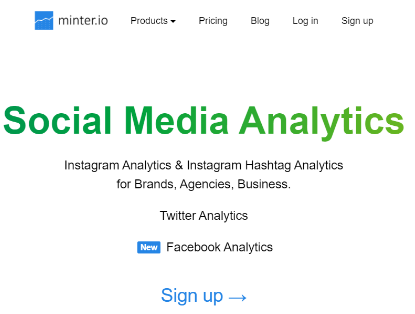
This is a social media statistics and analytics service for brands, businesses, and agencies. Minter.io tracks metrics for Instagram, Twitter, and Facebook. Some of the analytics data you can expect from it are:
- The number of the account/group subscribers.
- Subscriber gender and location.
- Number and quality of reactions to the posts.
- Dynamics of subscriber growth.
For Instagram users, the service collects and analyzes competitors’ hashtags, which may be very useful. It also allows comparing your account with your competitors’ based on the main metrics (number of followers, coverage, likes).
Minter.io will also suggest the best time to publish based on your audience’s activity online.
3. Iconosquare
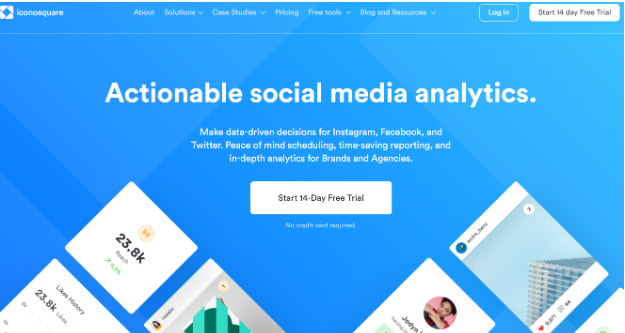
This is a tool for SMM on the major platforms: Instagram, Facebook, and Twitter. The service allows you to make informed decisions about social media promotions based on research data. What’s more, it helps organize the seamless workflow and keep track of multiple accounts on a single panel.
Iconosquare is suitable for small businesses and professional marketers, marketing teams, and agencies.
Here’s what it can offer:
- In-depth brand and agency analytics. A customizable dashboard allows you to visualize data.
- Scheduler for automatic publications with settings for time, location, tags, etc.
- Competitor and industry benchmarking for performance, subscribers, and reach. Available industry tests for more than 100 areas.
- Generate automatic marketing reports for teams and clients. The report files will be automatically delivered to specified inboxes.
4. SproutSocial
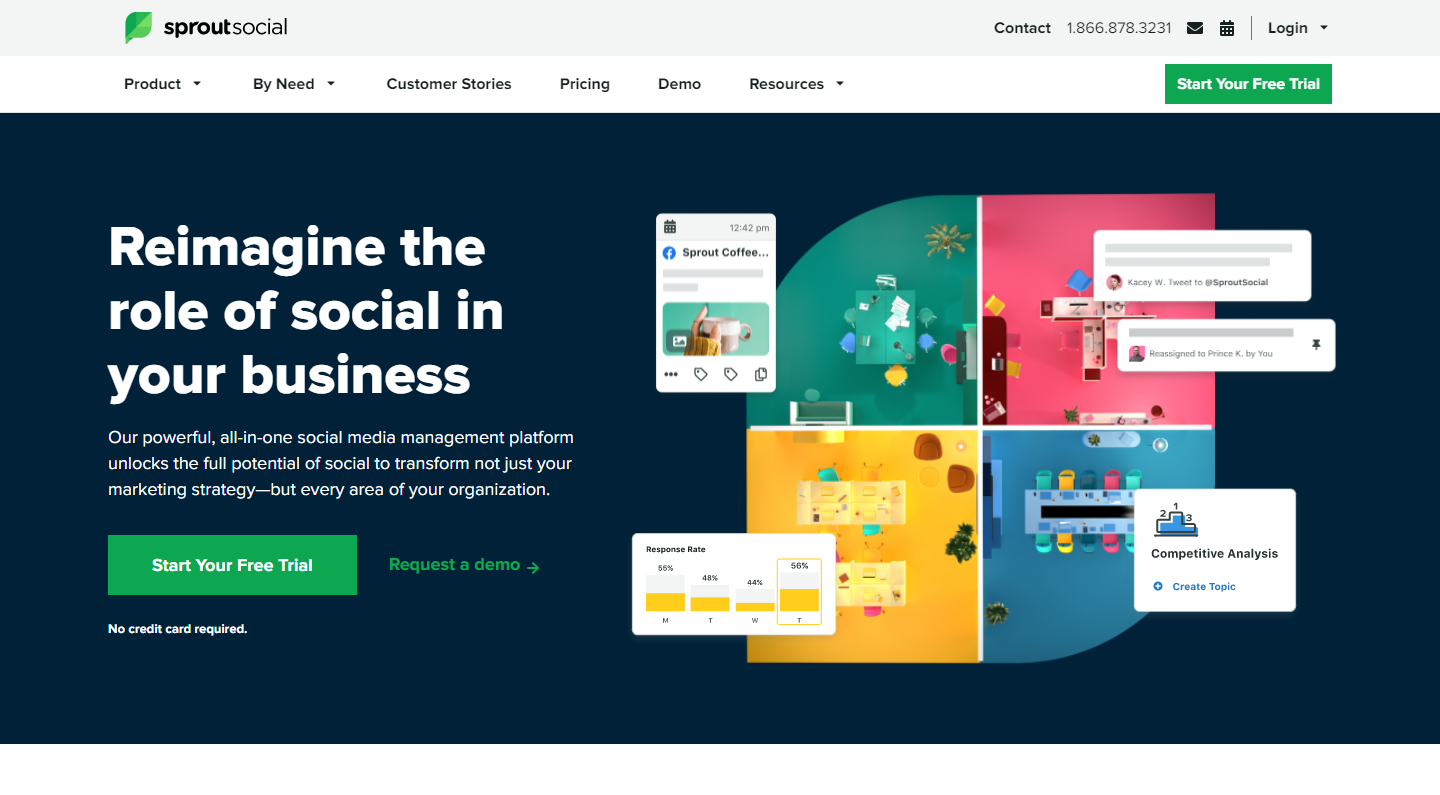
This is quite a universal social media reporting tool for social media managers and marketers, agents, analysts, and strategists. Using the resource allows you to reduce time spent on ancillary tasks and devote yourself to communicating productively with your audience. Social media is one of the largest and most transparent focus groups, communication with which brings many useful business ideas.
Some things it can offer are:
- Increasing your audience on social media.
- Identifying growth trends and based on that data, developing a business strategy.
- Understanding your audience and its needs.
- Evaluating your brand’s social media efficiency based on extensive statistical data.
- Planning and delivering content with the help of cross-network publications.
Conclusion
Metrics are important because their measurement and comparison let you see how successful your company’s SMM strategy and actions are. Budgets, resources, timelines, products, and processes can be better optimized by collecting and analyzing both quantitative and qualitative data that tells us how people interact with the brand on social media. Ultimately, key promotional metrics and subsequent optimization of marketing strategy should lead to an improved ROI on social media.
Engagement rate, audience demographics, and quality reach, conversion rate are among the most important metrics for your business. In combination and individually, they provide insight into the performance and results of social media marketing.
We also recommend to read
 How Does Instagram Promotion Work
How Does Instagram Promotion Work  Top-5 Influencer Marketing Alternatives to Promote Your Brand
Top-5 Influencer Marketing Alternatives to Promote Your Brand  How to Become an Instagram Manager
How to Become an Instagram Manager 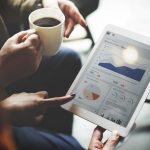 7 Key Instagram Statistics You Need to Track in 2021
7 Key Instagram Statistics You Need to Track in 2021  10 Best Influencer Marketing Platforms and Marketplaces in 2022
10 Best Influencer Marketing Platforms and Marketplaces in 2022  12 Best Influencer Marketing Agencies to collaborate with in 2021
12 Best Influencer Marketing Agencies to collaborate with in 2021Instagram Engagement Rate Calculator For Free
Check any influencer's Engagement rate and analyze his or her followers growth history
Other free tools: Follower Count History, Instagram Follower Count, CPM Calculator
